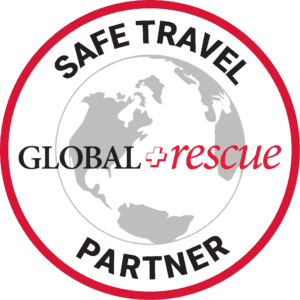|
Getting your Trinity Audio player ready...
|
Established in 1919
Zion National Park is an awe-inspiring and enchanting desert landscape carved from sandstone and sky. Its majestic walls are toweringly high, its canyons narrow and deep, and it has treasured experiences in store for everyone, big or small. It is Utah’s most celebrated national park.
Overview
Looking out over Zion Canyon from the top of Angels Landing, you’re transported. The colossal vertical faces of sandstone speckled in the dark green of desert foliage, presiding over the lush banks of the Virgin river is absolutely spectacular. For a moment, you forget where you are. The valley appears almost like the heart of some strange primordial jungle. You think to yourself, “what planet am I on right now?”
For all intents and purposes, Zion National Park may as well be its own planet. Its mysterious, desolate canyons trace meandering paths into the stone, forming deep, tranquil hallways of rock where snowmelt babbles over ancient cobblestones. It’s uniqueness is unparalleled. But the vast majority of Zion’s visitors never experience these remote delights. As visitation in Zion National Park continues to soar year after year, seeing the park has become exponentially more difficult. So we decided to put together a short handbook to Zion for you, the prospective adventurer, seeking solace in nature. Complete with the must-sees, some elusive bucket list items, some pro tips for how to manage it all, and a few more reasons to go (if there weren’t enough already). We present: the Adventurer’s Guide to Zion National Park, Utah.
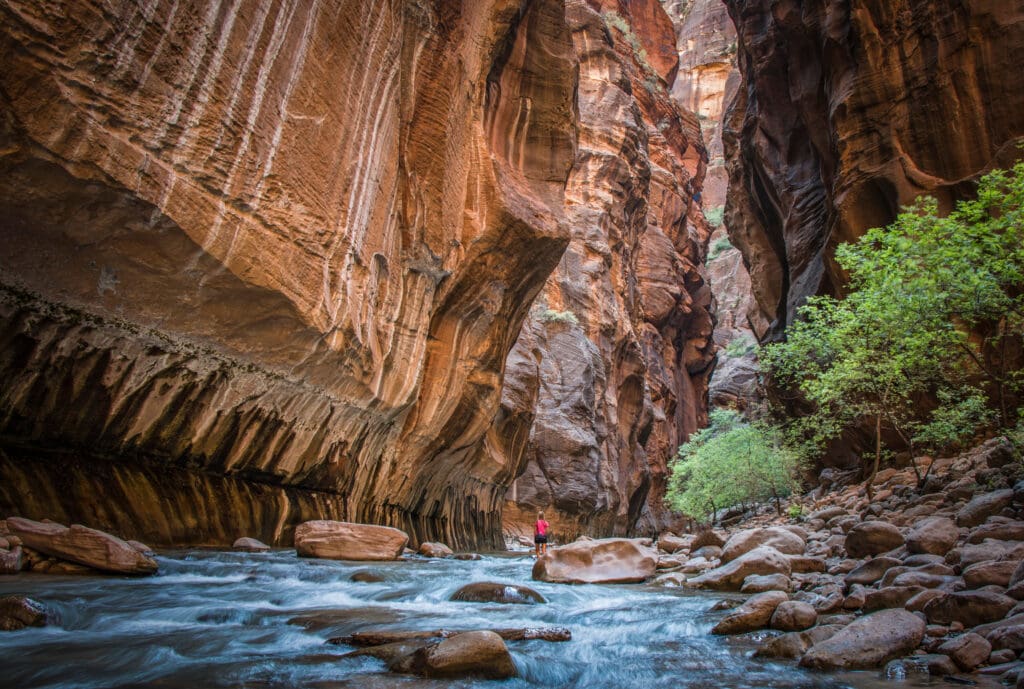
Hiking in The Narrows, Zion National Park, Utah. Photo: Micah/Adobe Stock.
Looking For An Amazing Adventure? Book A Guided Hiking or Camping Tour in Zion National Park, Utah with REI Adventures.
Table of Contents
Article Navigation: Click on any of the listed items in the table of contents below to jump to that section of the article. Similarly, clicking on any large, white section header will jump you back to the Table of Contents.
History
Maybe not too surprisingly, Zion has been occupied by human beings for a long time. The area’s first residents appeared sometime around 8,000 BCE. We have evidence of the practice of agriculture by native peoples dating back to around 2,000 BCE, comparatively much earlier than in other areas. A wealth of artifacts left behind by ancestral native peoples has been discovered in the neighborhood of the park. This includes early technology lke knives, drills, dart points, baskets, nets, sandals, and atlatls.
The verdant canyon bottoms of Zion were home to a number of cultures, including the Virgin Anasazi and Parowan Fremont. Much later, the Southern Paiute and Ute peoples would take up residence in Zion. The Paiute language inspired the park’s original name, Mukuntuweap, which is thought to mean “straight canyon” or “straight river”.
The first European eyes to fall on Zion were those of Silvestre Velez de Escalante, a Spanish missionary for whom Grand Staircase-Escalante National Monument and the town of Escalante are named. Explorer and frontiersman Jedediah Smith also visited the area. The Mormon pioneers were the first to settle the area around the Virgin River, founding the towns of Parowan and Cedar City. Zion Canyon itself was settled by Isaac Behunin, a farmer credited with naming the canyon. Major John W. Powell would later visit the canyon on his second trip down the Colorado River.
By the 1900s a star-studded cast of prominent people had already gazed on the natural beauty of Zion, but it was only going to become more famous. In 1904 images of Zion Canyon were featured at the Chicago World’s Fair and immediately sparked the imagination of thousands. In 1909, President Taft named Mukuntuweap National Monument, beginning a precedent for protecting the land from the impact of grazing and visitation. The name was changed to Zion in 1914 by the acting director of the National Park Service, hoping to boost tourism by using a term from the Mormon canon. Park status was granted in 1919, along with more land. The boundaries grew again in 1956, encompassing Kolob Canyon, and bringing the park’s boundaries to their current shape.
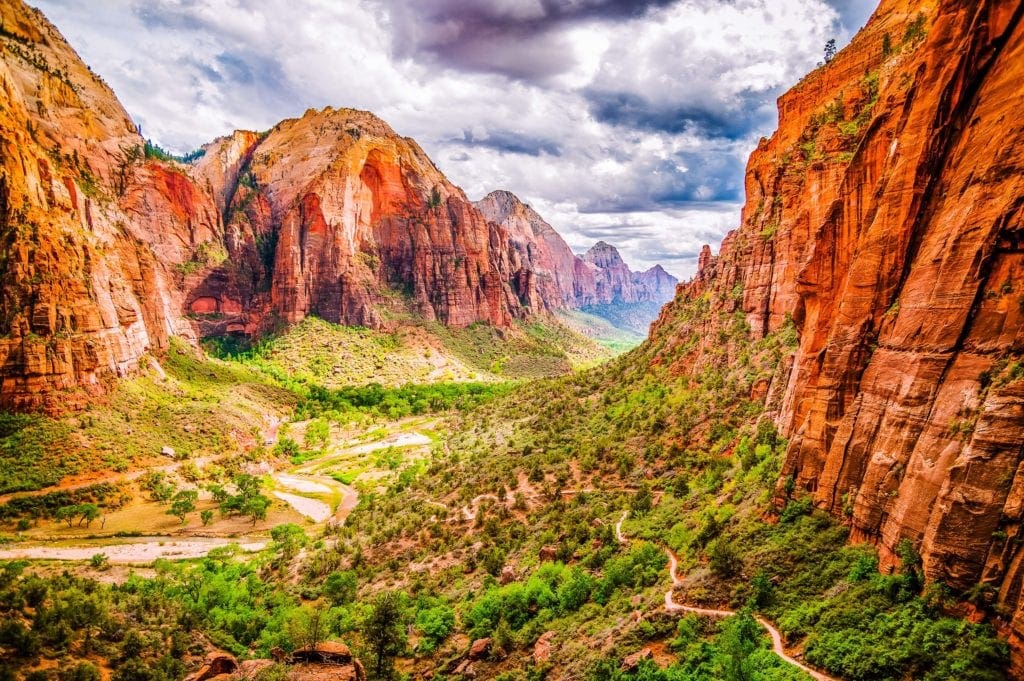
Colorful landscape in Zion Canyon, Utah.
Get cozy outdoors with Rumpl’s Zion National Park Original Puffy Blanket. Hike up Angel’s Landing or explore the Narrows in style with an eye-catching colorway inspired by Zion National Park.
Geology
Zion National Park is a showcase of the majesty of the Grand Staircase. This unique geological formation reveals hundreds of millions of years of geological history in layers of sandstone, each of which is distinct in its appearance. In Zion, as many as nine different layers of bedrock are visible. Most prominent among these are the Dakota Formation, Carmel Formation (also seen in Capitol Reef NP), and Navajo Sandstone (visible in Arches NP), all of which form smooth faces of exposed rock in different colors. Many of the larger formations around Zion also feature the Temple Cap Formation, which creates the rims many of the imposing domes of Zion Canyon.
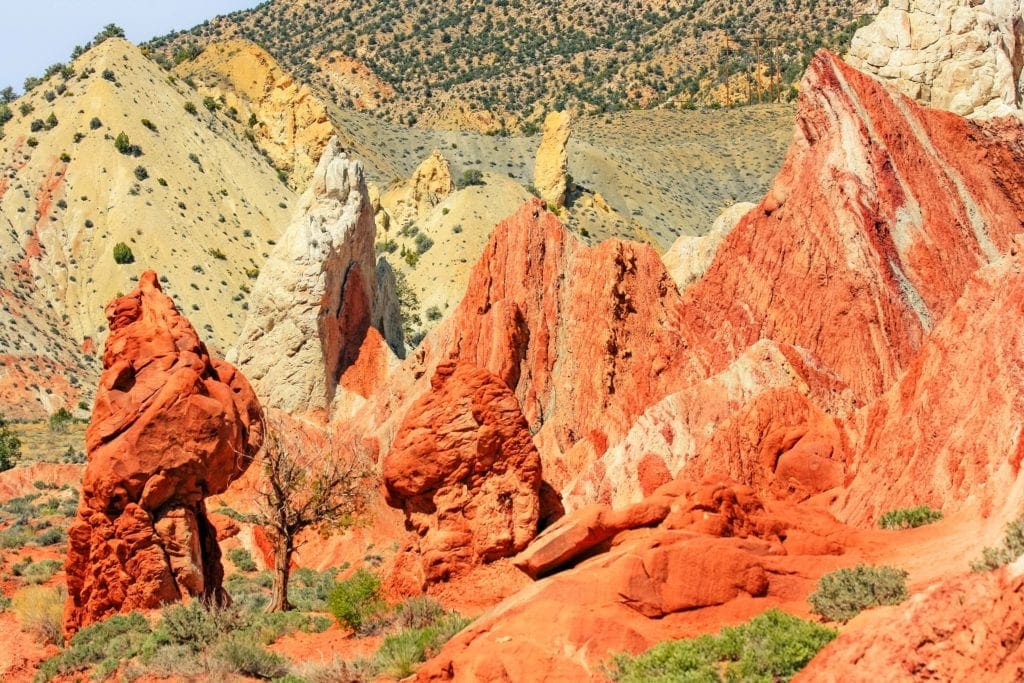
The Cockscomb formed along the steeply tilted sedimentary layers of a geologic feature known as the East Kaibab monocline. The Cockscomb, Grand Staircase–Escalante National Monument, Kane County, Utah.
Each of these layers of sandstone is millions to hundreds of millions of years old. They were revealed during an event of mass uplift which caused the formation of the Colorado Plateau. In combination with the constant weathering and erosion of the Virgin River, these layers form a sweeping variety of breathtaking geological shapes. Huge cliff faces, anticlines, slot canyons, arches, and towers can all be found in Zion. Many of these are worthy of mentioning (and we’ll mention quite a few down the road) but one that stands out especially is Kolob Arch, the sixth largest in the world. It’s such a dramatic sight that many people backpack overnight into the backcountry of Kolob Canyon just to see it.
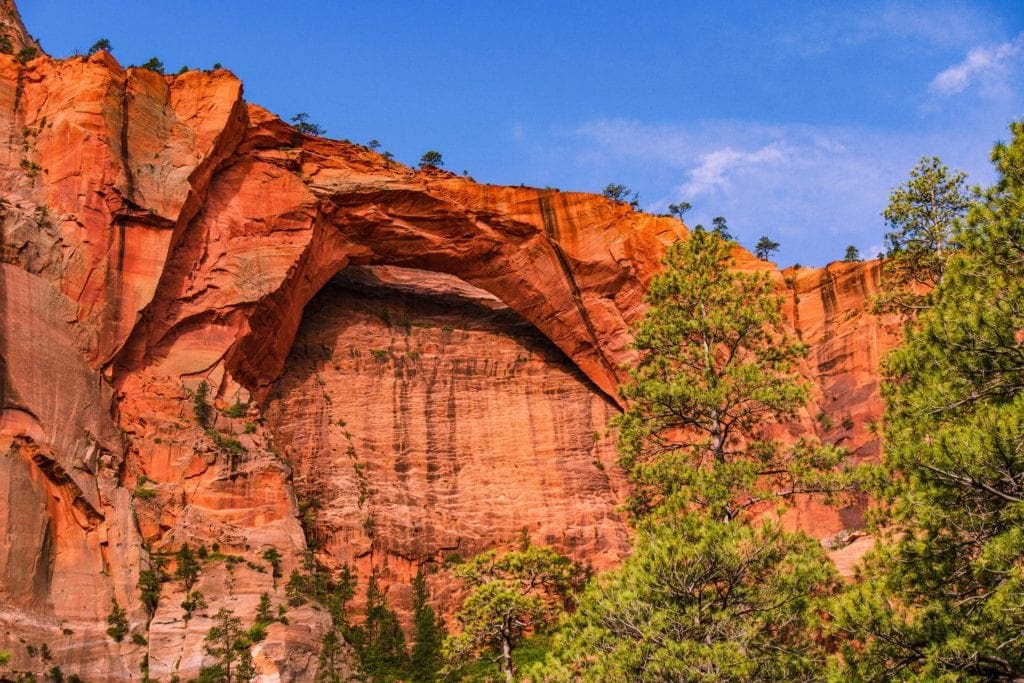
Kolob Arch on a beautiful Day
Canyon Country Ecosystems
Ecologically speaking, Zion sits at the convergence of three distinct regions: The Colorado Plateau, The Great Basin, and The Mojave Desert. Each of these regions supports a different community of living things. But here, they overlap, and the living things native to each place share the many nooks and crannies of Zion’s seemingly endless canyons. In addition, there is a huge gradient of elevation across the park, and plenty of water to go around. Because of all this, Zion is a hotbed of biological diversity. There are 409 documented species of animals that live in the park, including seven fish, six amphibians, 28 reptiles, 79 mammals, and a whopping 289 birds. This list of species contains everything from pure desert species like gila monsters, rattlesnakes, and desert tortoises to things you might not expect to see in the desert like beavers, leopard frogs, and California condors.
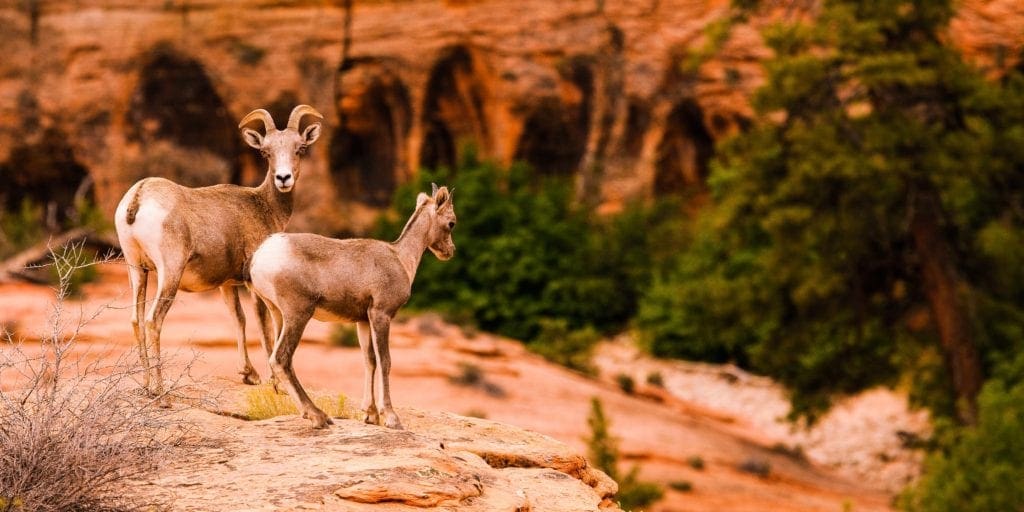
Mountain Goats in Zion National Park, Utah.
Supporting this diverse community of animal life is a whole slew of different plant communities. In Zion you can see Mojave-type deserts dominated entirely by cacti, mountainous forests of coniferous trees, and riparian zones teeming with deciduous trees and shrubs. As you gain elevation in the park, notice how your surroundings change. Different aspects where plants can receive more sun, shade, or water will support completely different ecosystems. Everything sits in its right place, cohabitating with everything else.
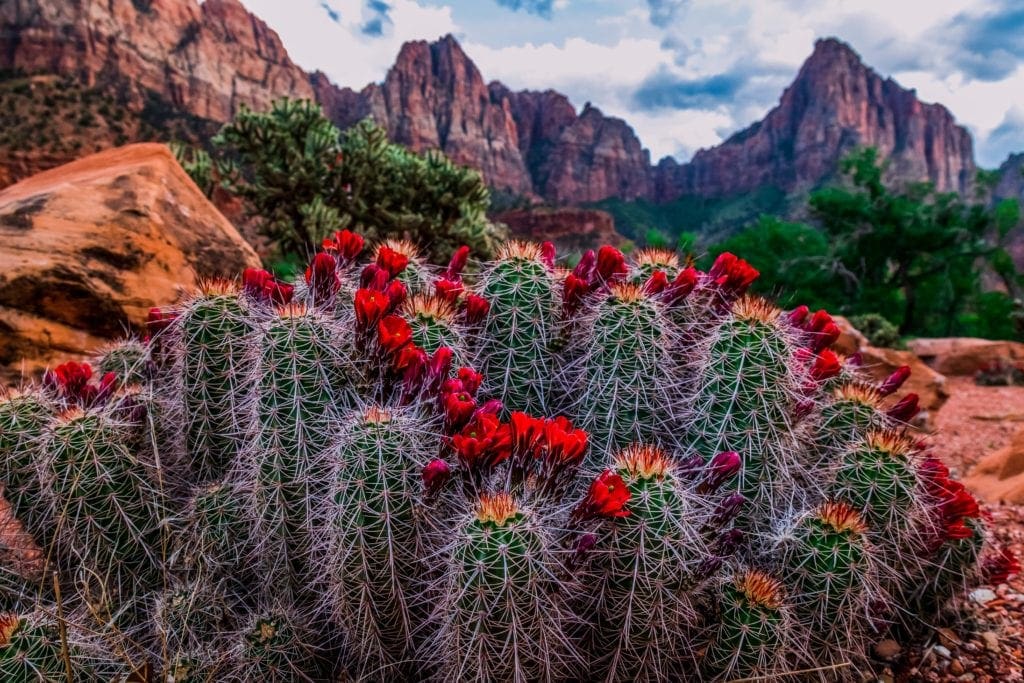
Claret Cup Cactus with red flowers in Zion National Park, Utah.
How To Visit
Zion is the mostly highly visited park in Utah. It averages well over 450,000 visitors per month in the busy season, which are concentrated mostly within the main scenic highway through the park. To combat the massive impact brought on by visitation, park officials have implemented a shuttle system which operates from April through October. If you plan on visiting some of the main destination in the park, such as Angel’s Landing and The Narrows, you will have to take a shuttle to get there.
However, you can outright skip the crowds and the hassle of the shuttle (not to mention temperatures pushing 110 degrees) by visiting in the off-season. Zion takes on an entirely different look in the fall and winter, and seeing the impressive formations without hundreds of other tourists around makes for a unique experience.
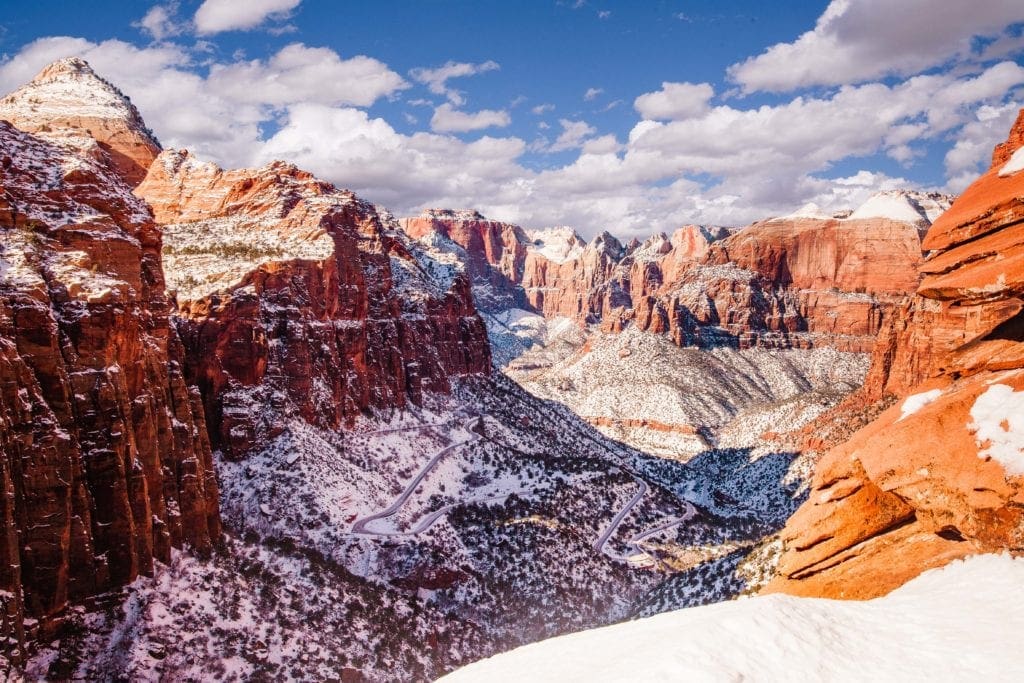
Fresh snowfall from the Canyon Overlook Trail in Zion National Park, Utah.
Another way to maximize your enjoyment is to get off the main drag in Zion. The Zion Canyon Scenic Drive captures the vast majority of the park’s visitors, and while it is stunning to see, there is plenty more worth your time in other parts of the park. Consider checking out Kolob Canyon, the East Rim, Kolob Terrace, or the Southwest Desert regions for more solitude. You won’t be at a loss for things to see or do, you’ll just have a little more space to think.
While in Zion, be sure to observe the Leave No Trace code of ethics. It’s impossible to eliminate the impact of visiting Zion National Park, but we can take steps to ensure that our ecological footprint on the pristine landscape is as minimal as possible. Camp responsibly, pack out waste, don’t take things from the park, and minimize the impacts of campfires to ensure that Zion remains beautiful for future generations.
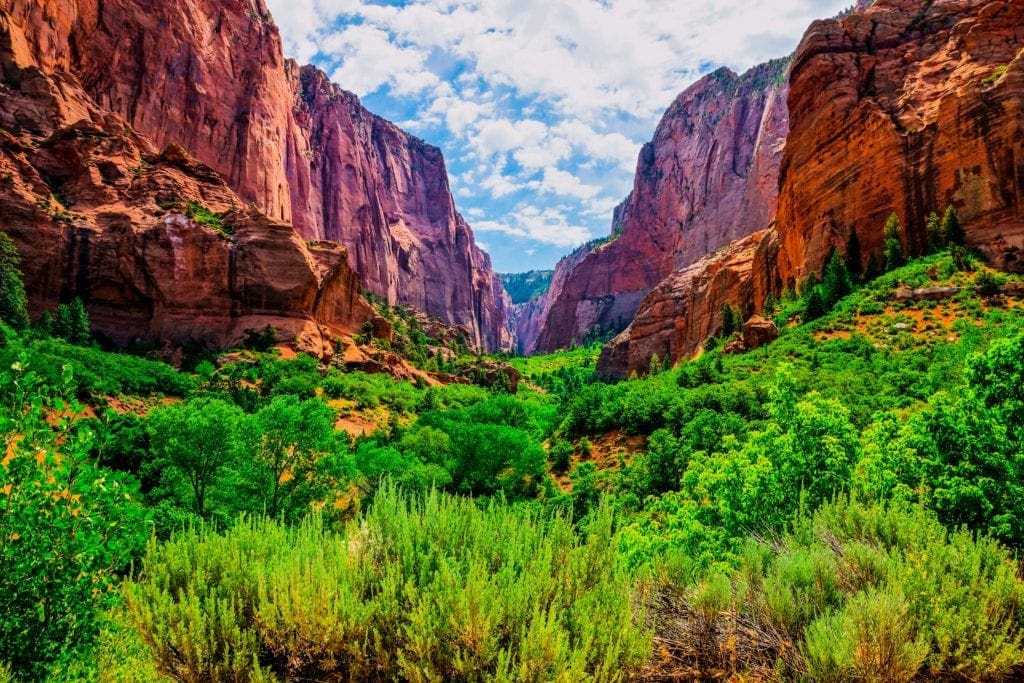
View through the red cliffs of Kolob Canyon in Zion National Park, Utah.
Main Attractions
As you approach the park, you’ll see the towering peaks of Zion looming in the distance. If this is your first trip to the park, you wouldn’t want to miss the major destinations along the Zion Canyon Scenic Drive. Most of the park’s “postcard picture” sights are located right along the Virgin River in Zion Canyon. You’ll park at the visitor center, hop on a shuttle, and proceed north, winding along the virgin river under the smooth canyon walls.
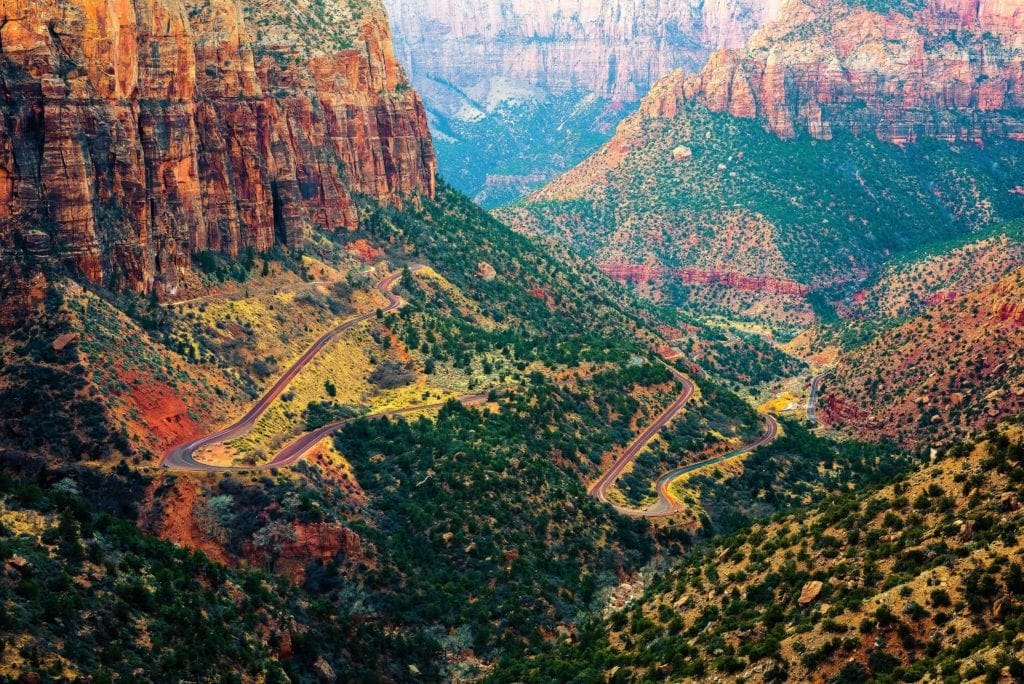
Zion Canyon and Mount Carmel Highway seen from Canyon Overlook in Zion National Park, Utah.
If this is your only day in Zion, spend it enjoying the many sights and trails along the Scenic Drive. You’ll see features like The East Temple, The Court of The Patriarchs, The Great White Throne, and Angels Landing before ending the drive at the Temple of Sinawava. From here you can proceed north on foot through The Narrows, a slot canyon that is usually partly full of water. This, along with the hike to the top of Angels Landing, are the two most classic hikes in Zion. If you were to hit all of these major destinations in a day, you definitely wouldn’t be disappointed with your trip.
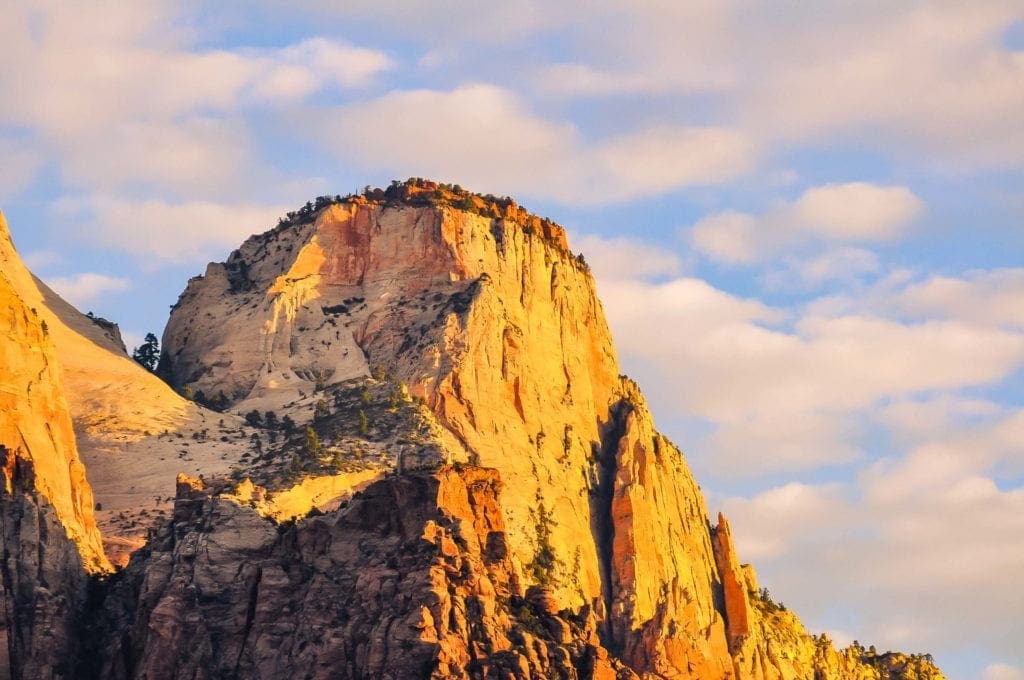
Great White Throne at Sunrise in Zion National Park, Utah.
Hiking
The main attraction of Zion National Park is its hiking trails. The park offers a range of options, suitable for both novice hikers and experienced adventurers. From tight slot canyons to expansive desert peaks and rocky cliffs, there are countless scenic destinations to explore in Zion National Park. Here are some of the must-see hikes in Zion National Park:
-
Angels Landing Trail – Considered one of Zion’s most famous trails, it offers breathtaking panoramic views. It’s a challenging hike, but the view from the top is worth the effort.
-
The Narrows – This hike takes you through the Virgin River, making it a unique and exciting experience. It’s perfect for those looking for an adventurous hike.
-
Observation Point – This trail provides a less crowded alternative to Angels Landing, with equally stunning views.
-
Emerald Pools Trail – A family-friendly hike that leads to three levels of pools. The trail is easy to moderate, depending on how far you hike.
-
Zion Canyon Overlook Trail – One of the shortest hikes in Zion, it offers a great view of the canyon without much effort.
-
Riverside Walk – A paved trail that follows the Virgin River, offering a peaceful and scenic walk.
-
Pa’rus Trail – A relatively easy trail that follows the Virgin River and is great for viewing wildlife.
-
Taylor Creek Trail – This trail leads to the Double Arch Alcove, a unique rock formation. It’s a moderate hike, perfect for those looking for a bit of adventure.
-
Watchman Trail – A moderate hike that offers views of the Watchman, a prominent peak in Zion, and the town of Springdale.
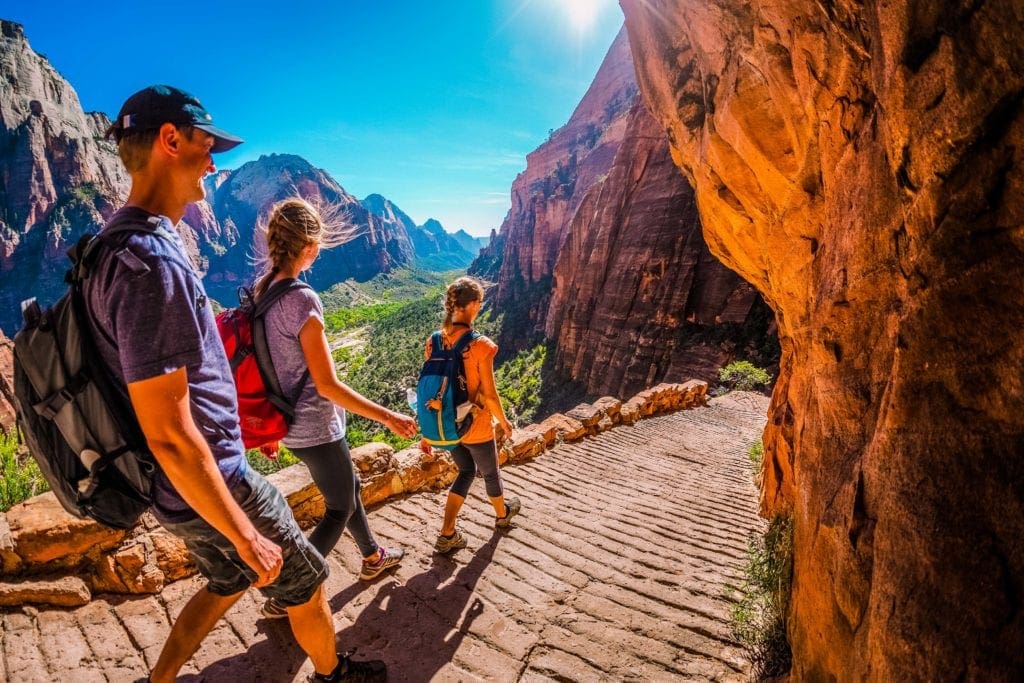
Group of hikers walking down the stairs and enjoying view of Zion National Park, Utah.
If you’re looking to get further from the main thoroughfare in the park, head east up the Zion-Mount Carmel Highway out of the east entrance before turning north to the East Rim area. From here, you could trek up to a few high points like Deertrap Mountain and Cable Mountain. Or, if you’re not up for huge distances, maximize your enjoyment on the East Rim trail or East Mesa Trail to Observation point, both of which provide excellent views of Zion Canyon.
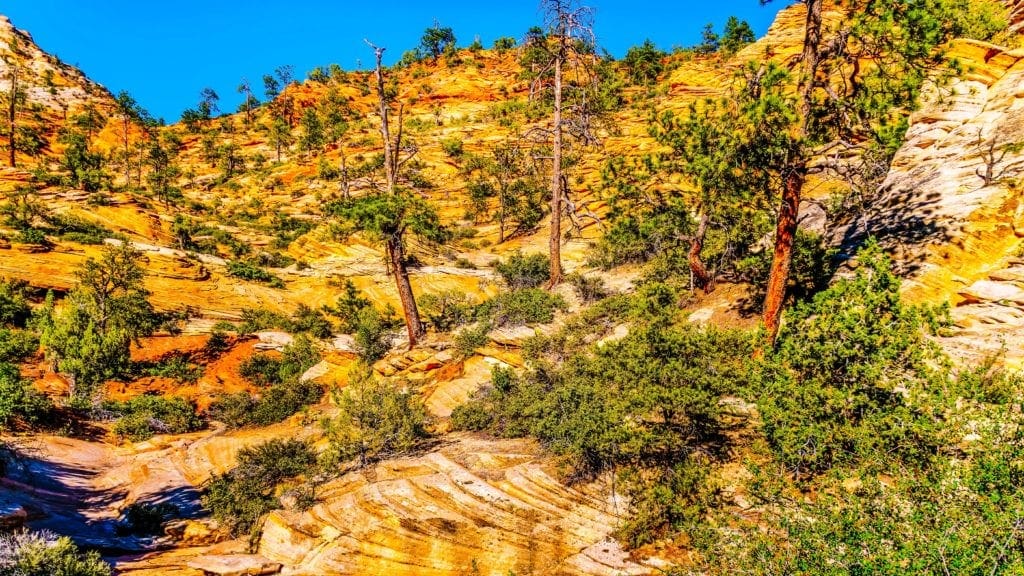
The white, yellow and orange colors of the sandstone at the East Rim of Zion National Park, Utah.
For even more room to yourself, take the Kolob Terrace Road to Kolob Terrace. There are plenty of out-and-back trails here that the vast majority of park visitors never even think of trying. Hikes like the Hop Valley Trail, Wildcat Canyon Trail, and Northgate Peaks Trail will give you a deeper appreciation for the vastness of the Zion Backcountry. You’ll cross through ponderosa pine forests, meadows, and side canyons, passing peaks and monoliths on all sides.
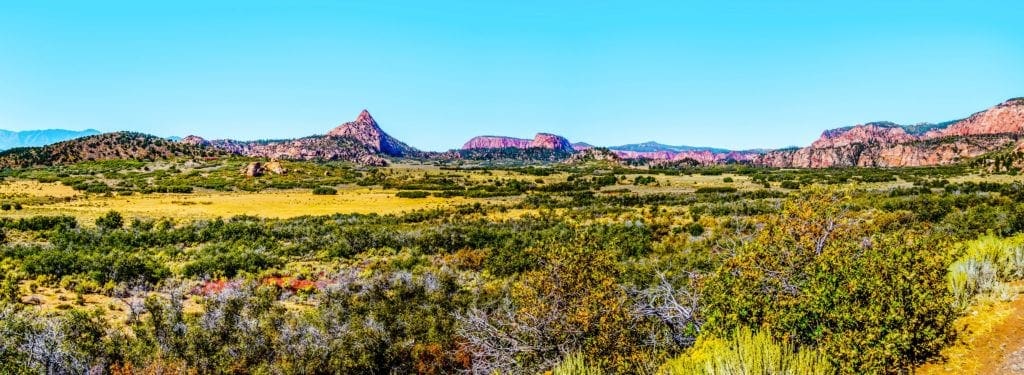
Panorama View of the Kolob Plateau in the Zion National Park, Utah, United States. Viewed from the Kolob Terrace Road with Pine Valley Peak in the background.
Camping
There are three campgrounds in Zion National Park, and all of them are worth some extra planning ahead of time. Campers will primarily stay at either South Campground or Watchman Campground, which are situated near the park entrance and have spectacular views of monoliths like The Watchman. They’re shaded by sparse trees, which is a godsend in the hot months, and give great access to the Zion Canyon Scenic Drive. Watchman Campground has 203 sites, and South Campground has 117, but these spots are almost always full during the busy season. Be sure to reserve a site in advance if you plan on camping in the park.
However, if you’re looking for a nice temporary home base to enjoy the Kolob Terrace area, Lava Point Campground is a no-brainer. Sitting at almost 8,000 feet, it stays cooler in the hot months and is forested by aspen and ponderosa pines, more reminiscent of a destination in the mountains than the desert. The campground has six primitive campsites, all of which are first come first served. The main downside to camping here is that there is no water available. But if you can deal with packing a little extra in, this is the best spot in the park for peace and quiet.
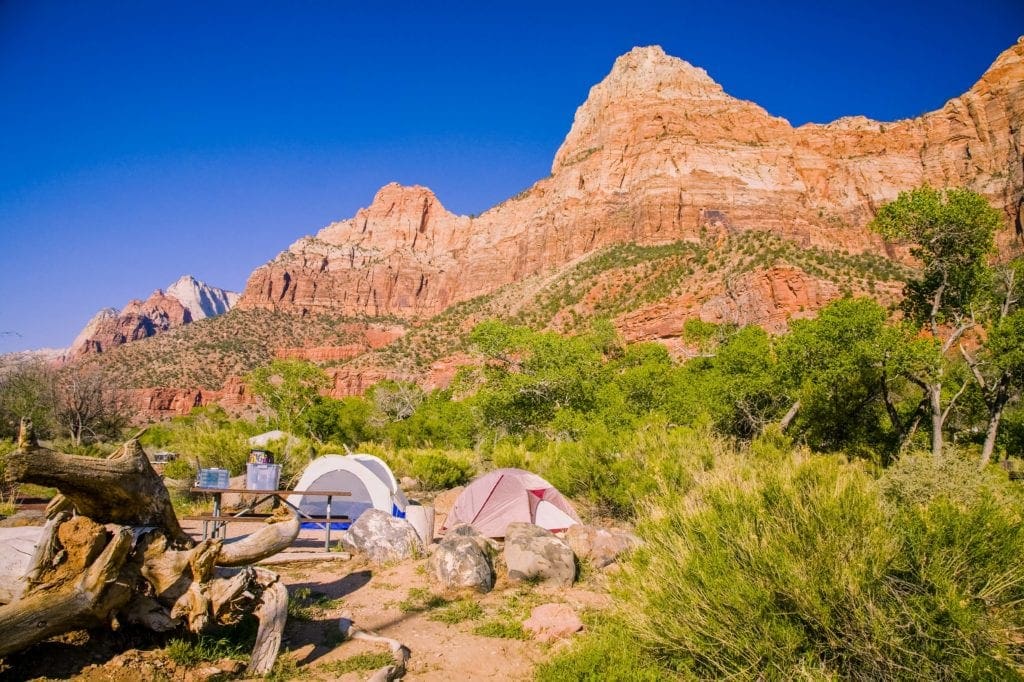
Tent camping at the South Campground in Zion National Park, Utah.
Backpacking
If you’re a lover of hiking and camping, why not put them together? Going for an overnight backpack through the Zion wilderness is probably the ultimate way to enjoy the park’s desolate charm. There are amazing backpacking routes in just about every corner of the park, from The Narrows, which you can follow for up to 16 miles up the North Fork of The Virgin River, to Hop Valley Trail, which can be done in combination with La Verkin Creek Trail to Kolob Arch. Other notable treks are the East Rim Trail and West Rim Trail, both of which cross along the precipitous edges of Zion Canyon.
There are a multitude of backcountry camping options available in Zion, as well as potential trails and destinations to take. The only real limit is your imagination (and what you can work out with park officials, of course).
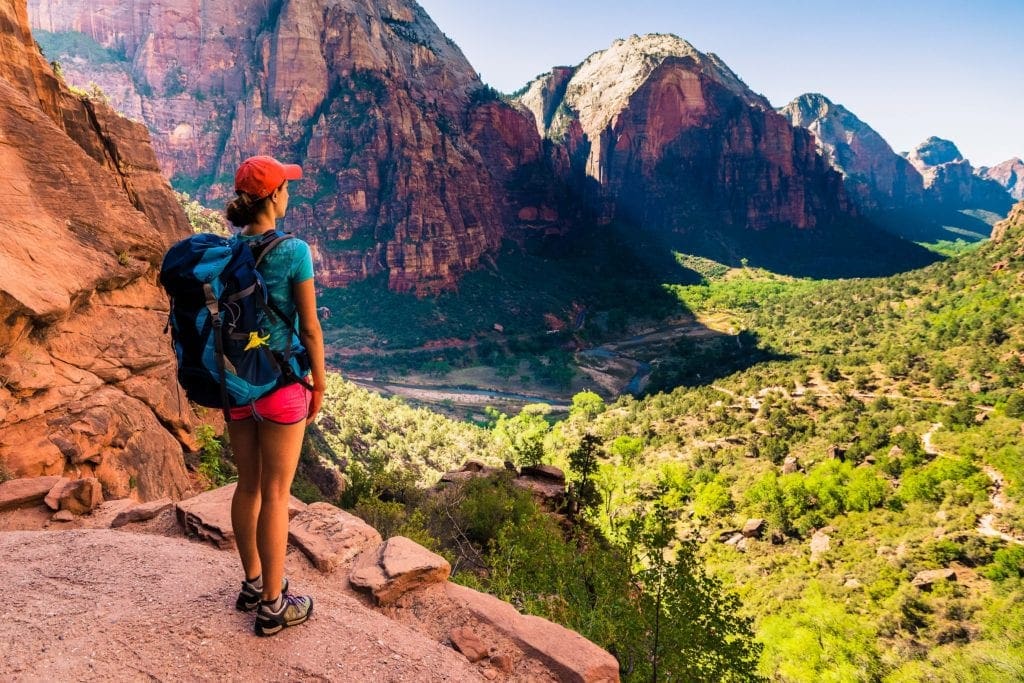
A backpacker is enjoying view on the trail to Angel’s Landing in Zion National Park, Utah.
Canyoneering
Hikes to overlooks and high points are all well and good, but if you want to go on a serious, bigtime adventure, you will definitely want to go canyoneering in Zion. Canyoneering combines elements of hiking, scrambling, and climbing with the objective of traversing winding red rock slot canyons. Some canyons are simple and can be hiked, like the portion of The Narrows most commonly done by day hikers. Another non-technical canyon of a similar difficulty is The Subway, a canyon that’s weathered to form an almost perfect cylindrical tube. Permits for The Subway can be obtained up to two months prior to your trip.
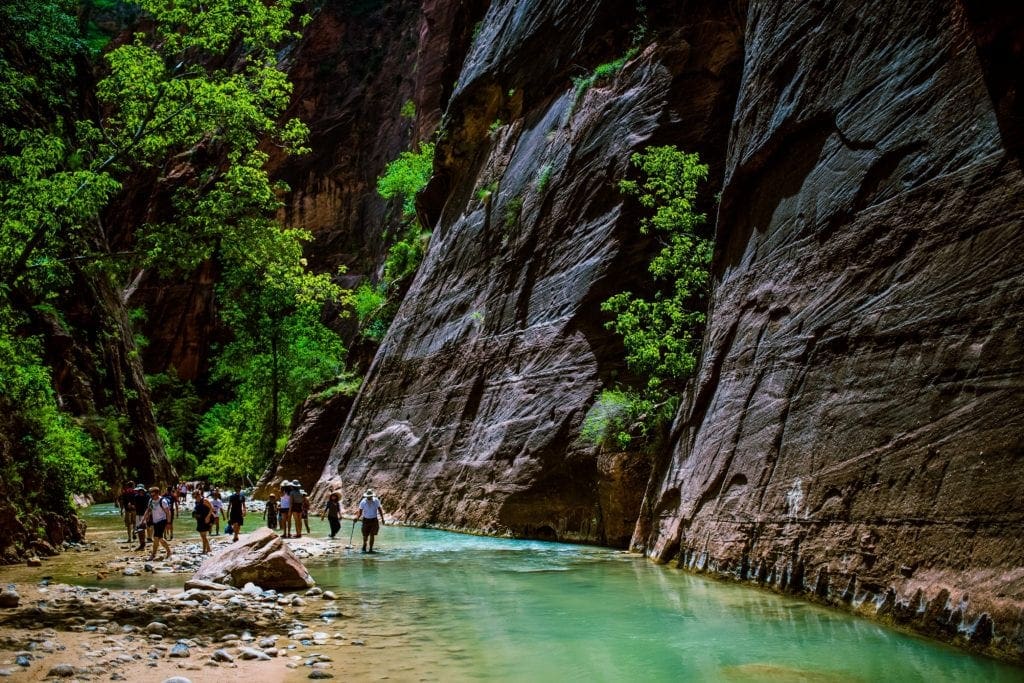
Canyoneering in the Narrows, Zion Canyon, Utah.
On the other hand, there are canyons which require ropes to rappel long vertical sections. This takes not only the gear necessary to rappel, but an intense understanding of how to use it without dying. Yes, dying, no joke. Technical canyoneering is an immensely dangerous undertaking that should be done first with a guide. Look into a local guiding company like Zion Adventures for more information on serious canyoneering adventures in Zion.
Zion Guide Hub offers a range of exciting canyoneering tours for visitors looking to explore Zion National Park and its surrounding areas. Their canyoneering tours include an exciting full-day (6-hrs) adventure through remote canyons, including safety orientation, gear fitting, hiking, scrambling, swimming, rappelling, and lunch.
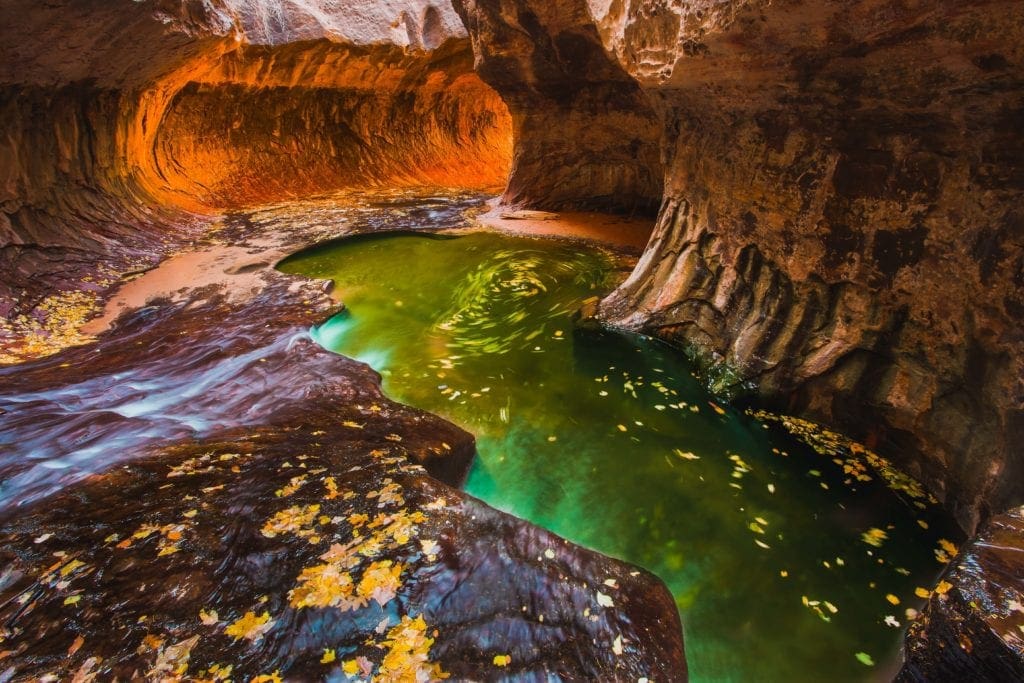
The Subway is a unique slot canyon and one of the most popular hiking destination in Zion National Park, Utah.
Climbing
As you could probably guess from all the mentions of giant rock faces in Zion, there’s a lot of amazing rock climbing to be done here. The most famous of these is The Moonlight Buttress, which can be done as a 5.8 C1 aid route or a 5.12c free route. But that’s just the tip of the iceberg. There are massive vertical walls of perfect sandstone all over Zion to take on, like The Headache, Prodigal Son, and Touchstone Wall. Tackling any of these would be a worthy feat for even veteran climbers. If you’re interested in checking off some bucket list routes while in Zion, be sure to get in touch with the park beforehand and get a permit for your intended climb. Be mindful of seasonal raptor closures and bat roosts while on the walls. These animals are highly sensitive to human influence and can be put at risk by human contact during certain times of the year.
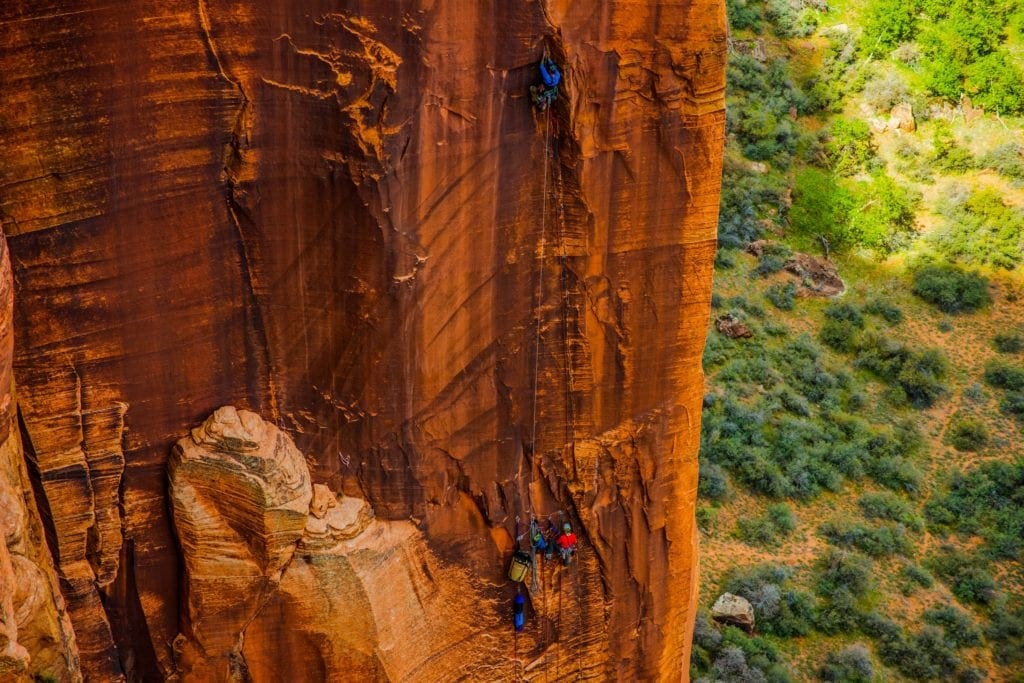
Climbers scaling sandstone wall in Zion National Park, Utah.
River Trips
If you’ve got the guts, you can also take on the Virgin River in a kayak. There are just a few options for river trips in the park. You can put in at the Temple of Sinawava and kayak to the Court of The Patriarchs, which is rated class II-III. This is a fantastic and scenic option that will be more accessible to most people. But you can also make arrangements with the park to take on The Narrows. Needless to say, this option is no joke. Kayaking The Narrows takes multiple days and includes class V whitewater. But if you’re hungry for adventure and not afraid to get wet, this is a river enthusiast’s dream.
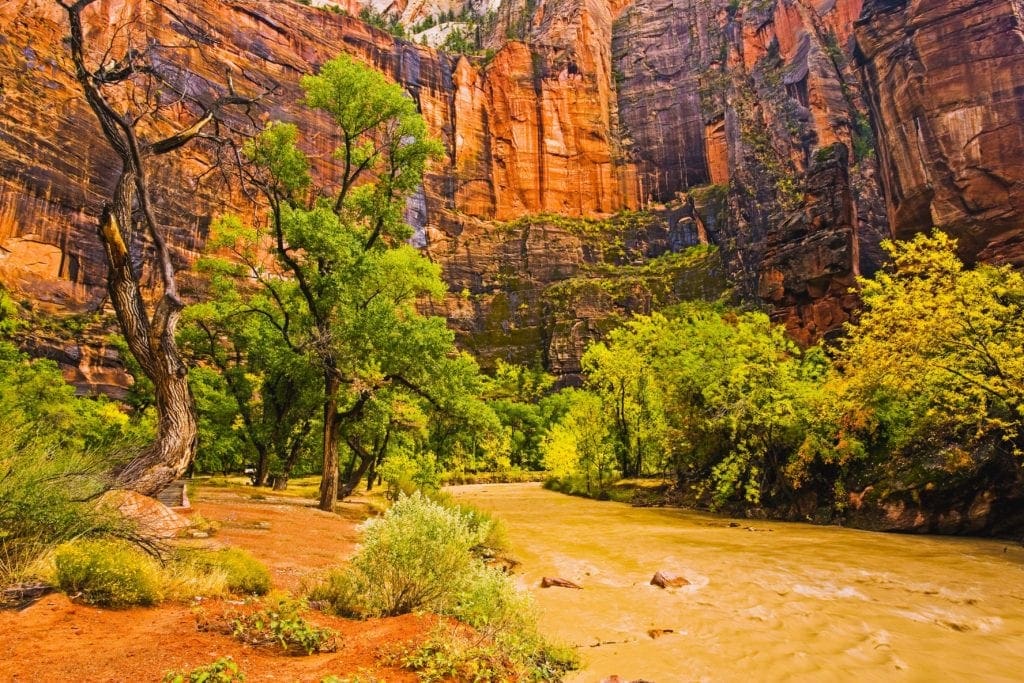
The Temple of Sinawava in Zion National Park, Utah
The Promised Land
There isn’t a wrong way to go about visiting Zion. If you’ve got the spirit of adventure, you’ll find something to fit your pace that you’ll remember forever. Whether that’s hiking Angels Landing for the ultimate photo-op, fording The Narrows to escape the summer heat, or rappelling hundreds of feet down into one of the park’s secret canyons. It’s all here, it’s all astounding, it’s all worth the trip. But what are you taking our word for? Go find out for yourself!
Enroll With Global Rescue Prior To Embarking On Your Next Adventure.
When a travel emergency arises, traditional travel insurance may not come to your aid, and a medical evacuation can cost up to $300,000.
The cost when you have a Global Rescue membership? $0. That’s why when the unexpected happens, you want the leader in rescue, evacuation and medical advisory behind you. You want Global Rescue.






